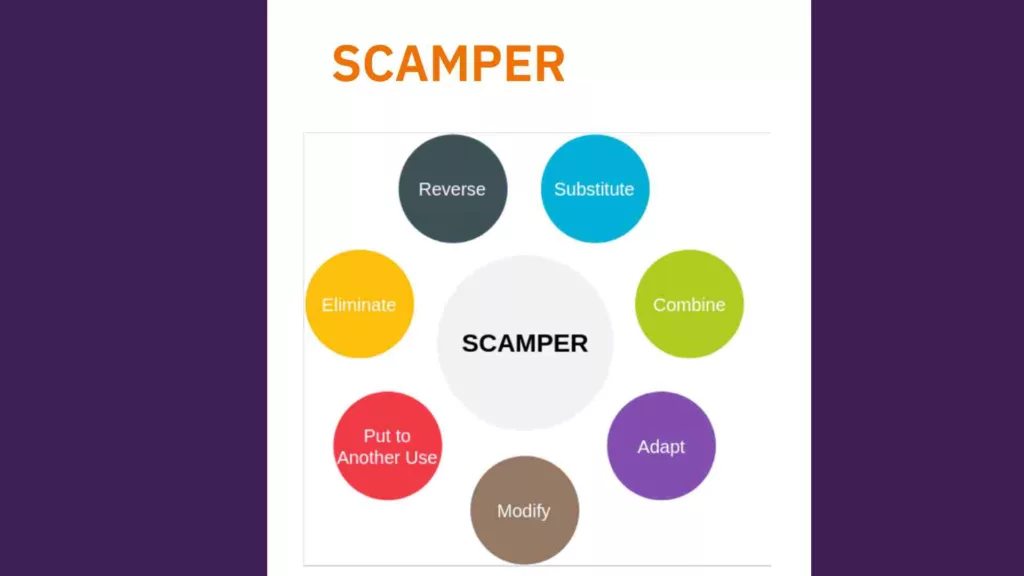Posted in Blog, Create, Design Thinking, Facilitation, Virtual Facilitation by Jo North
Introducing the SCAMPER Technique for Creative Problem Solving
In a world that is constantly evolving, the ability to think creatively and solve problems in innovative ways has become more crucial than ever. That’s where the SCAMPER technique comes in.
This powerful tool, coined by Alexander Osborn, and later Bob Eberle, offers a structured approach to thinking outside the box and generating fresh ideas. Whether you’re an entrepreneur looking to develop groundbreaking products or a marketer seeking unique ways to promote your brand, the SCAMPER technique can be a game-changer.
By breaking down different aspects of a problem, SCAMPER invites you to Substitute, Combine, Adapt, Modify, Put to another use, Eliminate, and Reverse your thinking. This comprehensive guide will delve into each step of the SCAMPER technique, providing practical examples and tips to help you unlock your creative potential. You’ll also find some more advanced tips and ideas for facilitating group brainstorming sessions with SCAMPER.
Get ready to level-up your problem-solving skills and ideate a world of possibilities with SCAMPER.
What is the SCAMPER technique?
The SCAMPER technique is a creative problem-solving method that encourages individuals to think differently and generate innovative solutions. Each letter in the acronym stands for a different aspect of the technique: Substitute, Combine, Adapt, Modify, Put to another use, Eliminate, and Reverse. By systematically applying these seven strategies, individuals and teams can explore new perspectives, challenge assumptions, and come up with unique ideas.

The first step in implementing the SCAMPER technique is to clearly define the problem at hand. Once you have a clear understanding of the problem, you can begin applying the different components of SCAMPER to stimulate creativity and generate new ideas. Let’s take a closer look at each element of the SCAMPER technique and how it can be used to approach problem-solving from a fresh perspective.
Understanding the components of SCAMPER
S – Substitute
The first component of the SCAMPER technique is Substitute. This involves replacing one element or component of a problem with something else. By considering alternative options, you can challenge conventional thinking and uncover new possibilities. For example, if you’re trying to improve the packaging of a product, you could substitute traditional materials with more sustainable alternatives. This simple substitution could not only enhance the overall sustainability of the product but also differentiate it from competitors in the market.
C – Combine
The next component of SCAMPER is Combine. This step involves merging different elements or ideas to create something new. By combining unrelated concepts, you can generate innovative solutions that may not have been considered before. For instance, if you’re a restaurant owner looking to attract more customers, you could combine the concept of a traditional cafe with a bookstore to create a unique and cozy reading cafe. This combination not only provides customers with a relaxing environment to enjoy their favorite books but also offers a delicious menu for them to indulge in.
A – Adapt
The third component of SCAMPER is Adapt. This involves making modifications or adjustments to an existing idea or product to better suit a specific context or purpose. By adapting existing solutions, you can cater to different needs and target new markets. For example, if you’re a software developer looking to create a mobile app, you could adapt an existing desktop application to make it more user-friendly and compatible with mobile devices. This adaptation allows you to tap into the growing market of smartphone users and expand your customer base.
M – Modify
The Modify component of SCAMPER focuses on making changes or alterations to an existing idea or product. This step encourages individuals to think critically about how they can improve upon existing solutions. By making modifications, you can enhance functionality, aesthetics, or overall performance. For instance, if you’re a car manufacturer looking to design a more eco-friendly vehicle, you could modify the engine system to reduce emissions and improve fuel efficiency. This modification not only aligns with the growing demand for sustainable transportation but also positions your brand as an industry leader in environmental consciousness.
P – Put to another use
The Put to another use component of SCAMPER challenges individuals to explore alternative applications or purposes for an existing idea or product. By thinking outside the box, you can uncover new markets or uses that may have been overlooked. For example, if you’re a clothing designer struggling to find sustainable materials for your designs, you could consider repurposing discarded fabrics or materials to create unique upcycled garments. This approach not only reduces waste but also provides customers with one-of-a-kind pieces that align with their values.
E – Eliminate
The Eliminate component of SCAMPER encourages individuals to identify and remove unnecessary elements or steps from a process or solution. By eliminating nonessential components, you can streamline processes, reduce costs, and improve efficiency. For instance, if you’re a software developer working on a new app, you could eliminate complex registration forms and opt for a simpler social media login option. This elimination not only simplifies the user experience but also reduces barriers to entry and increases user adoption.
R – Reverse
The final component of SCAMPER is Reverse. This step involves flipping the perspective or approach to a problem. By considering the opposite or reverse of a conventional solution, you can challenge assumptions and uncover unique insights. For example, if you’re a marketing manager looking to promote a new product, you could reverse the traditional approach of targeting a broad audience and instead focus on a niche market. This reversal allows you to tailor your messaging and marketing efforts to a specific group, increasing the likelihood of engagement and conversion.

Applying the SCAMPER technique to real-life scenarios
Now that we have a solid understanding of each component of the SCAMPER technique, let’s explore how it can be applied to real-life scenarios.
Example 1: Product Innovation
Let’s say you’re an entrepreneur looking to develop a groundbreaking product. By applying the SCAMPER technique, you can unlock new possibilities and differentiate yourself from competitors. Here’s how each component of SCAMPER can be used:
– Substitute: Consider alternative materials or technologies to improve the performance or sustainability of your product.
– Combine: Merge different features or functions to create a unique product that caters to multiple needs.
– Adapt: Modify an existing product to suit a specific target market or context.
– Modify: Make improvements or alterations to an existing product to enhance its functionality or aesthetics.
– Put to another use: Explore alternative applications or markets for your product to expand its reach.
– Eliminate: Identify and remove unnecessary features or components to simplify the product and reduce costs.
– Reverse: Challenge conventional thinking by considering the opposite or reverse of a traditional solution.
By systematically applying these strategies, you can generate innovative ideas and develop a product that stands out in the market.

Example 2: Marketing Strategy
Now let’s consider a marketer seeking unique ways to promote their brand. By using the SCAMPER technique, you can uncover creative marketing strategies that capture the attention of your target audience. Here’s how each component of SCAMPER can be applied:
– Substitute: Explore alternative advertising channels or mediums to reach a wider audience.
– Combine: Merge different marketing techniques or platforms to create a cohesive and engaging campaign.
– Adapt: Modify your messaging or branding to resonate with a specific demographic or cultural context.
– Modify: Make changes or adjustments to your marketing materials to improve their effectiveness or visual appeal.
– Put to another use: Repurpose existing content or assets to create new marketing materials or campaigns.
– Eliminate: Identify and remove unnecessary marketing activities or channels that yield low ROI.
– Reverse: Challenge traditional marketing norms by adopting unconventional approaches or messaging.
By incorporating these strategies into your marketing efforts, you can create unique and impactful campaigns that set your brand apart.

Tips for using the SCAMPER technique effectively
While the SCAMPER technique is a powerful tool for creative problem-solving, it’s essential to approach it with the right mindset and follow some best practices to maximize its effectiveness. Here are some tips for using the SCAMPER technique effectively:
1. Embrace curiosity and open-mindedness: Approach each component of SCAMPER with a sense of curiosity and a willingness to explore new ideas. Be open to unconventional approaches and perspectives.
2. Collaborate and brainstorm: The SCAMPER technique is even more effective when used as a collaborative tool. Gather a diverse group of individuals and encourage brainstorming sessions to generate a wide range of ideas.
3. Break down the problem: Before applying the SCAMPER technique, ensure you have a clear understanding of the problem at hand. Break it down into its key components to facilitate the application of each SCAMPER strategy.
4. Combine SCAMPER strategies: Don’t limit yourself to using only one SCAMPER strategy at a time. Experiment with combining multiple strategies to generate even more innovative ideas.
5. Iterate and refine: The SCAMPER technique is an iterative process. Continually evaluate and refine your ideas, incorporating feedback and making necessary adjustments along the way.
6. Practice, practice, practice: Like any skill, the more you practice using the SCAMPER technique, the better you’ll become at generating creative ideas. Make it a habit to apply SCAMPER to various problems and scenarios, both in your personal and professional life.
How to Facilitate Group Brainstorming Sessions with the SCAMPER technique
As a facilitator, you can use the SCAMPER brainstorming method in different ways for creative problem solving, to catalyze the imagination development of team members, leading to original ideas for new products or improving the current product. Employ SCAMPER as a problem solver for specific problems, allowing team members to explore creative ways of generating ideas. This simple technique can provoke thought-provoking questions, enhance critical thinking, and stimulate new insights.
Remember that like any ideation technique, SCAMPER is a brainstorming process, so no idea is bad at this stage. Encourage a safe space for all contributions, let the creative juices flow, and remember that the best ideas often come from the hard work of refining and iterating.
Here is a variety of other options for you to consider.
SCAMPER to Challenge the Status Quo
Begin your session with a holistic approach to the existing process or current situation. Use the SCAMPER template as a starting point and guide for your team members, asking them to view the problem or product through different lenses. This provides a different perspective and a design thinking approach, challenging the status quo and opening the path for new ways of thinking.
Thomas Edison once said, “There’s a way to do it better – find it.” The same philosophy drives SCAMPER methodology. By using the SCAMPER mnemonic, team members can dig deeper into the product features, its different techniques, and how they can be improved, leading to new things that were not considered before.
Prompt Great Ideation Questions
Use the action verbs from the SCAMPER acronym to prompt different questions, ensuring you cover all elements of the product or parts of the process. The Substitute prompt, for example, can be used to explore how parts of the product can be replaced to achieve a fresh product. Take the digital camera as a great example. Traditional film cameras were substituted with digital technology, giving birth to an entirely new market segment.
The Combine prompt is another powerful part of your process. Like Ray Kroc, who combined fast food with franchising to form the McDonald’s we know today, your team can look for unrelated ideas that, when combined, form a compelling new product or business model. The Combine prompt also serves as an idea manipulation tool, helping team members to look at the problem from different angles.
Focus on the Human Factor
Ensure you adopt a human factor into the design thinking process. The best way to develop a product’s success is to keep your target group in mind at all times. Apple’s decision to introduce the magnetic plug is an effective way to illustrate this. The design idea not only offered utility but also kept user safety at the heart of the innovation.
Use SCAMPER on Specific Elements
Encourage your team to consider different elements of their concept, and identify the most important parts. Breaking down your initial idea into smaller pieces will help your team focus on each design element individually, fostering a different context for each feature, which in turn encourages a thorough examination of the overall process.
Keep Everyone On Track
Lastly, to keep track of these sessions, use PowerPoint presentations or a similar tool to record the progress and the series of questions and ideas that arise. This provides an effective visual aid for team members and keeps the focus sharp. In the end, your role as a facilitator is to steer the creative thinking meeting and ensure that the SCAMPER methodology is followed effectively to derive maximum benefits.
Review the Results
As the process ends, review the results. Remember that SCAMPER isn’t just about creating new products; it is a great way to challenge and improve your existing process. Like any design process, SCAMPER should be part of your concept, consistently pushing boundaries and opening up paths for innovation. This is the beauty of this tool – it offers endless possibilities for any creative problem-solving scenario.

Challenges and limitations of the SCAMPER technique
While the SCAMPER technique is a valuable tool for creative problem-solving, it’s important to be aware of its limitations and potential challenges. Here are a few considerations to keep in mind:
1. Limited by existing knowledge: The effectiveness of the SCAMPER technique heavily relies on the individual’s knowledge and experiences. If you’re not exposed to a wide range of ideas, it may be challenging to generate truly innovative solutions using SCAMPER alone.
2. Overemphasis on novelty: While the SCAMPER technique encourages thinking outside the box, it’s important not to prioritize novelty at the expense of practicality or feasibility. Ensure that your ideas are not only creative but also viable and aligned with your goals.
3. Lack of structure: The SCAMPER technique is a flexible and open-ended approach, which can be both a strength and a weakness. Some individuals may find it challenging to navigate the absence of a strict structure and may require additional guidance or frameworks.
4. Not a one-size-fits-all solution: The SCAMPER technique may not be suitable for all types of problems or situations. It’s essential to assess the context and consider alternative problem-solving methods that may better align with specific challenges.
Next Steps
The SCAMPER technique is a powerful tool for creative problem-solving, offering a structured approach to thinking outside the box and generating fresh ideas. By applying the Substitute, Combine, Adapt, Modify, Put to another use, Eliminate, and Reverse prompts, individuals and teams can unlock their creative potential and level-up their problem-solving skills. Whether you’re an entrepreneur, marketer, workshop facilitator, or simply someone looking to enhance your creativity, the SCAMPER technique can help you approach problems from new perspectives and uncover innovative solutions. Embrace the SCAMPER technique, break free from conventional thinking, and unleash a world of possibilities.
For more insights and tips on advancing your creative problem solving and facilitation skills, take a look at my articles here, Design Thinking 101 and 10 Top Design Thinking Tips.


